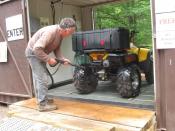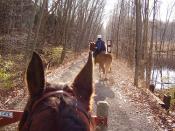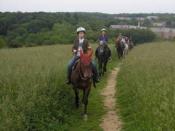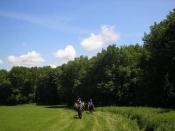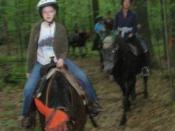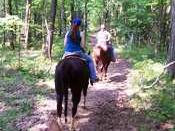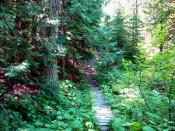Recently, all over the U.S, more and more local, regional and even federal agencies are working to close down and take over recreational Off-Highway Vehicle areas. Some areas of the country, including Wallowa County, do still allow OHV users to ride in areas that are on non-private land at certain times of the year. But with new rules now being considered, this could soon change. Local clubs are fighting to keep even small pieces of land available for public motorized recreation and access.
One of the best ways to keep areas open is to establish trails that are used consistently and responsibly by many people. In order to do that, someone has to actually map existing trails or create new ones. The tough part about that is that the trails can't just consist of open fire roads or old logging roads. For the most part, they need to be on non-used over-grown routes not visible to a major traveled road.
The first step to developing a trail or system of trails is Planning. You have to find out what areas ATV, dirtbikes or snowmobiles are legally allowed to ride in. There are a lot of agencies and rules that determine where you can ride, and that even changes throughout the year. Sometimes it's posted in the area, but often it's not, so do your homework.
Always respect private land owner's rights also. They may give you permission to run all or part of your trail on their land, or they may forbid it. You would hate to do all the work it takes to develop a trail, and then find out you will not be allowed to use it, or worse, you could be required to repair the area back to it's previous state.
Once you have determined the area is open for riding, next you'll want to determine where people would like to have more trails. Go to a local club meeting and propose what you would like to accomplish and where you would like to do it. If you are building trails in an area where you know people already want to ride, you're not only more likely find help to make it, but you will get more continued use of the trail. And if other local riders invest their own time, they will be more apt to use it responsibly.
Once you have decided where you want to develop trails, you need to find out if it is even possible, based on terrain. Depending upon the amount of debris and other variables in the area of your proposed trail, you might need to revise where you would like to create the trail.
You have to take into consideration if there are bodies of water, steep terrain, or other natural obstacles between the starting and the ending points of the trail. It will be hard to know before you actually reach that point at the trail, but you might not be able to cross water or get around a fallen tree for example. You have to determine how much work you are willing to do, can afford to do, or even are allowed to do.
The best way to decide your exact route, is to first walk where you want to go. That way you won't make any more tracks in the area then you absolutely have to and you won't do any permanent damage to areas you don't end up using, but you can easily find your route later.
This step of the process will most likely take you most of a day, so take something with you to mark your route as you go. We use fluorescent plastic tape that is not dangerous to the animals or the environment, but is easy to see while on foot or from an ATV. This surveying ribbon is relatively inexpensive and available at most hardware stores.
In addition to using tape for a simple and visual reference, another way to mark a new trail is by using a Global Positioning Satellite unit, or GPS. A GPS is a great way to log where you've been and easily follow the same path again. When you do have GPS technology it is possible to share your exact mapping with other people. The way points logged on your GPS, as well as details like significant elevation changes, can be transferred onto a computer. Then others can download the information to their GPS too or even print it out in a map format.
Now that you have planned the route of the trail, the tough part starts. Whether you are making a trail from scratch or just clearing an existing one, there are a few pieces of equipment that you will need to complete the job.
Quite often logs or other objects block the trail. If they are too large to move and you aren't able to go easily around, the trail is going to have to go over or through them. We always carry a small chainsaw and a small can of mixed fuel when building new or maintaining existing trails.
It's also handy to have a winch mounted on your ATV. That way, you can just pull a log out of the way - either the cut portion, or the entire log if you can.
When we have room, we like to carry a small fold-up shovel with us. If your trail goes near a bank or hill, it might be necessary to cut out a little of the hillside to make it safe. Remember you are building a trail wide enough for a motorized vehicle, but don't permanently change any more of the ground than you need to.
Once the trail is correctly marked and clear of any obstructions, it's important to get the word out. If the trail isn't used, it will be much tougher to keep the trail ride-able. Why should the government keep a trail open to the public if no one uses it?A good way of getting the trails known to many people is to hold club rides that use the trail. Many ATV and motorcycle clubs hold poker runs or fun runs. If the route includes your new trail and riders like it, they will tell their friends and they will use it on their own time.
Every one of these steps has to be completed by a dedicated person if there is any hope to make a trail or whole trail system. So many people complain about losing their riding areas, but how many actually work to keep trails to ride?It takes a great amount of time and work to complete and maintain a safe, legal, and fun trail. If you really want to ride now and in the future, you'll get your butt off the couch and start making yourself a place to ride!

